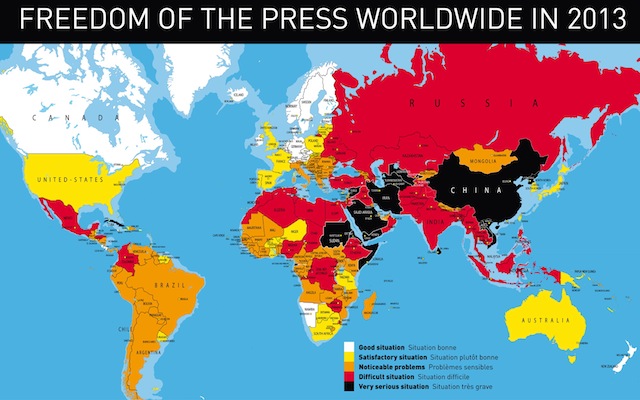SUMMARY
This is AI generated summarization, which may have errors. For context, always refer to the full article.

MANILA, Philippines – In a country that has failed to enact a Freedom of Information law and where media killings continue, it comes as no surprise that the Philippines retained its low global ranking as far as press freedom is concerned.
The Philippines ranked 147 out of 179 countries surveyed in the 2013 World Press Freedom Index by Paris-based organization Reporters Without Borders or Reporters Sans Frontieres (RSF) — a drop of 7 places from 2012.
While last year’s index was marked by the Arab Spring protests, RSF said this year’s rankings were not influenced by any “dramatic political developments.”
“This year’s index is a better reflection of the attitudes and intentions of governments towards media freedom in the medium or long term,” RSF said in its report.
How does one explain the drop in the Philippines’ ranking? The report did not indicate the specific events or factors that influenced the Philippines’ ranking.
RSF, however, based its global report on 6 factors:
- pluralism or options presented to the media
- media indepedence or the degree to which media are able to function independently of authorities
- environment and self-censorship
- legislative framework or the quality of legislative framework and its effectiveness
- transparency
- infrastructure
The RSF reported there was a general decline in press freedom in the Asia-Pacific, with 25 countries placing at the bottom 45 of the index.
Only Burma or Myanmar registered a notable improvement in the rankings after the government moved to free journalists and netizens from prison and outlaw censorship.
For 2013, Asia Pacific ranks 4th among all regions in the world.
‘Not surprising’
National Union of Journalists of the Philippines secretary-general Rowena Paraan said the Philippine ranking was to be expected, given the Aquino administration’s lack of decisive action against media attacks and its failure to pass the Freedom of Information bill.
Based on how the countries were categorized, Paraan said 3 major factors continue to restrict press freedom in the Philippines: the killing of media practitioners; the absence of a Freedom of Information bill; and the slow progress of cases involving media killings, particularly the Ampatuan massacre.
“Kapag ito ang mga tinignan, hindi ka talaga magugulat. Mas nakakagulat pa kung umakyat ang Pilipinas sa rankings,” Paraan said. (If you look at these factors, you will not be surprised. It would even be more surprising if the Philippines went up the rankings.)
In a January 2013 report, the Center for Media Freedom and Responsibility (CMFR) recorded 4 work-related killings involving journalists in 2012, a decline from 6 in 2011. While there were fewer media killings in 2012, CMFR said none of the cases since 2009 have been solved.
The first journalist killed in Asia in January 2012 also came from the Philippines, according to RSF.
The Philippines hit its lowest ranking in the World Press Freedom Index in 2010 after the November 2009 massacre of 58 people in Ampatuan, Maguindanao in November. At least 32 journalists were killed in the incident.
Three years after, the case remains unsolved, as the arraignment of one of the primary suspect in the massacre, former Autonomous Region in Muslim Mindanao Gov Zaldy Ampatuan, only happened in December 2012.
Meanwhile, the Freedom of Information Bill continues to languish in Congress. With only 4 days left in the legislative calendar, members of the House of Representatives have yet to start the period of debates for the measure.
Unlike what he did with the reproductive health and sin tax laws, Aquino has so far not expressed any indication of certifying FOI as urgent. This, despite the fact that the House of Representatives adopted Malacañang’s FOI version as early as March 2012.
Outlook for media freedom
Paraan said President Benigno Aquino III’s earlier pronouncements criticizing the media for publishing negative reports also does not bode well for the outlook on media freedom in the Philippines.
“He has been consistent. Listen to the pronouncements of the President. Masungit sa media. He has been consistent in whining about government reports, consistent in blaming us for critical reports against the administration,” Paraan said.
“This is surprising because if you ask academics and observers of the media, they will say that the media has been nice to the Aquino administration because of the general goodwill that they have been showing toward [it],” she added.
Europe is top
Europe is at 1st place with a score of 17.5, followed by North and South America with 30.0, Africa with 34.3, Asia with 42.2, and North Africa with 48.5.
While media freedom in Asia still needs improvement, the same 3 countries in Europe have retained the top spots. Finland, Netherlands and Norway continue to be the 3 places with the best media freedom conditions in the world
There was no improvement on the part of the 3 countries at the bottom of the index — Turkmenistan, North Korea and Eritrea. – Rappler.com
Add a comment
How does this make you feel?
There are no comments yet. Add your comment to start the conversation.